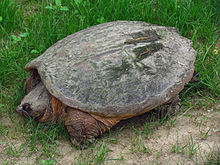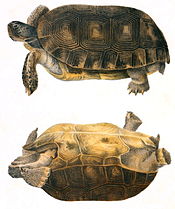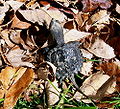- Common snapping turtle
-
Common snapping turtle 
Looking for a place to lay eggs, Ottawa, Ontario Conservation status Scientific classification Kingdom: Animalia Phylum: Chordata Class: Reptilia Order: Testudines Family: Chelydridae Genus: Chelydra Species: C. serpentina Binomial name Chelydra serpentina
(Linnaeus, 1758)
Range map of C. serpentina Synonyms Testudo serpentina Linnaeus, 1758
Chelydra serpentina - Schweigger, 1812The common snapping turtle (Chelydra serpentina) is a large freshwater turtle of the family Chelydridae. Its natural range extends from southeastern Canada, southwest to the edge of the Rocky Mountains, as far east as Nova Scotia and Florida and as far southwest as northeastern Mexico. This species and the larger alligator snapping turtle are the only two species in this family found in North America (though the common snapping turtle, as its name implies, is much more widespread).[1]
Common snappers are noted for their belligerent disposition when out of the water, their powerful beak-like jaws, and their highly mobile head and neck (hence the specific name "serpentina", meaning "snake-like"). In some areas they are hunted very heavily for their meat, a popular ingredient in turtle soup. These turtles have lived for up to 47 years in captivity, while the lifespan of wild individuals is estimated to be around 30 years.[2]
Contents
Anatomy and morphology
Chelydra serpentina have rugged, muscular builds with ridged carapaces (though ridges tend to be more pronounced in younger individuals). The carapace (upper shell) length in adulthood may be nearly 50 cm (20 in), though 25–47 cm (9.8–19 in), is more common,[3] with C. serpentina and its subspecies commonly weighing 4.5–16 kg (9.9–35 lb). Exceptionally large (often captive and overfed) individuals may reach 34 kg (75 lb).
Ecology and life history
Common habitats are shallow ponds, shallow lakes, or streams. Some may inhabit brackish environments, such as estuaries. Common Snapping Turtles sometimes bask—though rarely observed—by floating on the surface with only their carapace exposed, though in the northern parts of their range they will also readily bask on fallen logs in early spring. In shallow waters, Common snappers may lie beneath a muddy bottom with only the head exposed, stretching their long necks to the surface for an occasional breath (note that their nostrils are positioned on the very tip of the snout, effectively functioning as snorkels). Snapping turtles are omnivores, consuming both plant and animal matter, and are important aquatic scavengers; but they are also active hunters that prey on anything they can swallow, including many invertebrates, fish, frogs, reptiles (including snakes and smaller turtles), unwary birds, and small mammals.
Snappers will travel extensively overland to reach new habitat or to lay eggs. Pollution, habitat destruction, food scarcity, overcrowding and other factors will drive snappers to move overland; it is quite common to find them traveling far from the nearest water source. This species mates from April through November, with their peak laying season in June and July. The female can hold sperm for several seasons, using it as necessary. Females travel over land to find sandy soil in which to lay their eggs, often some distance from the water. After digging a hole, the female typically deposits 25 to 80 eggs each year, guiding them into the nest with her hind feet and covering them with sand for incubation and protection. Incubation time is temperature-dependent, ranging from 9 to 18 weeks. In cooler climates, hatchlings overwinter in the nest.
Systematics & taxonomy
Currently no subspecies of the common snapping turtle are recognized.[4] The former subspecies osceola is now considered a synonym of serpentina, while the other former subspecies Chelydra rossignonii[5] and Chelydra acutirostris are both recognized as full species.[4][6]
Behavior
Snapping turtles have "fierce" dispositions;[7] however, when encountered in the water, they usually slip quietly away from any disturbance.[8] Snapping turtles have evolved the ability to snap because unlike other turtles, they are too large to hide in their own shells when confronted. Snapping is their defense mechanism. However, these turtles rarely bite humans; they usually flee when threatened.
The snapper is an aquatic ambush hunter, capturing its prey with its beak-like jaws.[8]
Captivity
The common snapping turtle is not an ideal pet. Its neck is very flexible, and the turtle can bite its handler even if picked up by the sides of its shell. The turtle can amputate a finger with its powerful jaws. It will make a hissing sound when it is threatened or encountered; however, when in the water and unprovoked, they are fairly docile toward humans.
It is a common misconception that common snapping turtles may be safely picked up by the tail with no harm to the animal; in fact, this has a high chance of injuring the turtle, especially the tail itself and the vertebral column.[9] Lifting the turtle with the hands is difficult and dangerous. Snappers can stretch their necks back across their own carapace and to their hind feet on either side to bite. Also, their claws are sharp and capable of inflicting significant lacerations.
It may be tempting to rescue a snapping turtle found in a road by getting it to bite a stick and then dragging it out of immediate danger. This action can, however, severely scrape the legs and underside of the turtle and allow for deadly infections in the wounds.
Invasive species
In Italy in recent years large sexually mature adult Chelydra serpentina have been taken from bodies of water throughout the country. They were most probably introduced by the unwise release of pets. In March 2011 an individual weighing 20 kilograms (44 lb) was captured in a canal near Rome.[10]
In politics
The common snapper was the central feature of a famous American political cartoon. Published in 1808 in protest at the Jeffersonian Embargo Act of 1807, the cartoon depicted a snapping turtle, jaws locked fiercely to an American trader who was attempting to carry a barrel of goods onto a British ship. The trader was seen whimsically uttering the words "Oh! this cursed Ograbme" ("embargo" spelled backwards). This piece is widely considered a pioneering work within the genre of the modern political cartoon.[citation needed]
The year 2006 saw the snapping turtle declared the state reptile of New York by a sweeping vote of the New York Legislature after being popularly chosen by the state's public elementary school children.[11]
References
- ^ C.H. Ernst (2008). "Systematics, Taxonomy, and Geographic Distribution of the Snapping Turtles, Family Chelydridae". In A.C. Styermark, M.S. Finkler, R.J. Brooks. Biology of the Snapping Turtle (Chelydra serpentina). John Hopkins University Press. pp. 5–13.
- ^ Bosch, A. (2003). "Chelydra serpentina: Information". Animal Diversity Web. http://animaldiversity.ummz.umich.edu/site/accounts/information/Chelydra_serpentina.html. Retrieved 2008-07-20.
- ^ Kindersley, Dorling (2001,2005). Animal. New York City: DK Publishing. ISBN 0-7894-7764-5.
- ^ a b Rhodin, Anders G.J.; van Dijk, Peter Paul; Inverson, John B.; Shaffer, H. Bradley (2010-12-14). "Turtles of the world, 2010 update: Annotated checklist of taxonomy, synonymy, distribution and conservation status". Chelonian Research Monographs 5: 000.xx. Archived from the original on 2010-12-15. http://www.webcitation.org/5uzfktoIh.
- ^ van Dijk, P.P., J Lee, J., Calderón Mandujano, R., Flores-Villela, O., Lopez-Luna, M.A. & Vogt, R.C. (2007). Chelydra rossignoni. In: IUCN 2008. IUCN Red List of Threatened Species. Downloaded on 2009-05-04.
- ^ Chelydra, Reptile Database
- ^ Snapping Turtle, Encyclopedia.com
- ^ a b Common Snapping Turtle, Nature.ca
- ^ Indiviglio, Frank (2008-06-24). "Handling Snapping Turtles, Chelydra serpentina, and Other Large Turtles". That Reptile Blog. That Pet Place. http://blogs.thatpetplace.com/thatreptileblog/2008/06/24/handling-snapping-turtles-chelydra-serpentina-and-other-large-turtles/. Retrieved 2008-07-20.
- ^ Una "azzanatrice" catturata fuori Roma. March 17, 2011. Corriere della Sera. Milan.
- ^ Medina, Jennifer (2006-06-23). "A Few Things Lawmakers Can Agree On". N.Y./Region (New York Times). http://www.nytimes.com/2006/06/23/nyregion/23ladybug.html?_r=1&oref=slogin. Retrieved 2008-07-20.
Gallery
-
Illustration from Holbrook's North American Herpetology, 1842
-
Held by a Great Blue Heron
External links
- The Snapping Turtle Page - www.chelydra.org
- Snapping Turtle - Chelydra serpentina Species account from the Iowa Reptile and Amphibian Field Guide
- Common Snapping Turtle, Natural Resources Canada
- Video: How to Help a Snapping Turtle Cross A Road from the Toronto Zoo
The Chelydridae family of turtles Kingdom: Animalia · Phylum: Chordata · Class: Reptilia · Order: Testudines · Suborder: Cryptodira · Family: ChelydridaeGenus Chelydra Macrochelys Phylogenetic arrangement of turtles based on turtles of the world 2010 update: annotated checklist of taxonomy, synonymy, distribution and conservation status. Extinct turtles are not included.Order Testudines (turtles) Suborder SuperfamilySubfamily
Cryptodira Caretta · Chelonia · Eretmochelys · Lepidochelys · NatatorDermochelysDermatemydidaeDermatemysStaurotypinaeBatagur · Cuora · Cyclemys · Geoclemys · Geoemyda · Hardella · Heosemys · Leucocephalon · Malayemys · Mauremys · Melanochelys · Morenia · Notochelys · Orlitia · Pangshura · Rhinoclemmys · Sacalia · Siebenrockiella · VijayachelysAldabrachelys · Astrochelys · Chelonoidis · Chersina · Cylindraspis · Geochelone · Gopherus · Homopus · Indotestudo · Kinixys · Malacochersus · Manouria · Psammobates · Pyxis · Stigmochelys · TestudoTrionychiaCarettochelyidaeCarettochelysTrionychinaePleurodira ChelidinaeChelodininaeHydromedusinaePhylogenetic arrangement based on turtles of the world 2010 update: annotated checklist. Extinct turtles not included.
See also List of Testudines families
 Portal ·
Portal ·  WikiProjectCategories:
WikiProjectCategories:- IUCN Red List least concern species
- Chelydra
- Reptiles of North America
- Reptiles of Central America
- Reptiles of South America
- Reptiles of the United States
- Reptiles of Ontario
- Reptiles of Guatemala
- Living fossils
Wikimedia Foundation. 2010.











